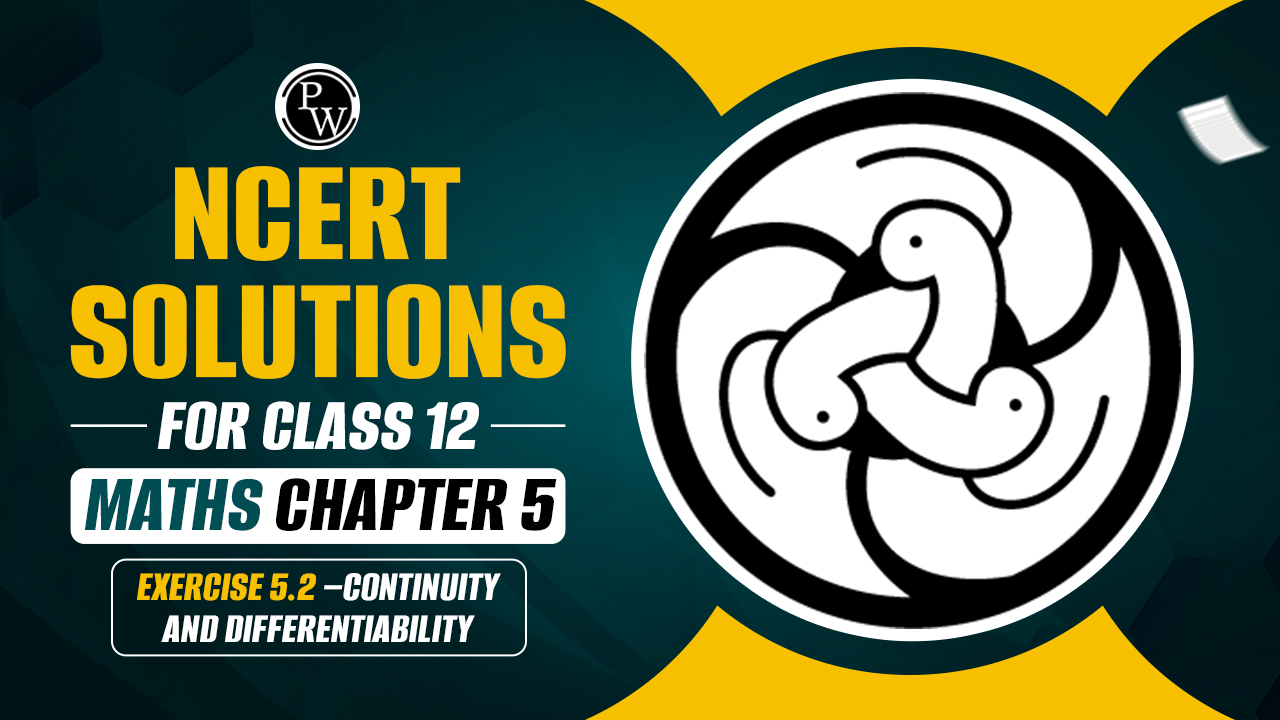NCERT Solutions for Class 12 Maths Chapter 5 Exercise 5.2 – Continuity and Differentiability

Class 12 Maths Chapter 5 Exercise 5.2 – Continuity and Differentiability:- Continuity and Differentiability are fundamental concepts in calculus, essential for understanding the behaviour of functions. Continuity ensures that a function has no interruptions or breaks in its graph at a given point. Formally, a function f(x)f(x)f(x) is continuous at x=cx = cx=c if limx→cf(x)=f(c)\lim_{x \to c} f(x) = f(c)limx→cf(x)=f(c). Different types of discontinuities, such as jump, infinite, and removable discontinuities, will be examined.
Differentiability, on the other hand, means that a function has a defined tangent at a point, indicating the function is smooth and has no sharp corners at that point. A function f(x)f(x)f(x) is differentiable at x=cx = cx=c if limh→0f(c+h)−f(c)h\lim_{h \to 0} \frac{f(c+h) - f(c)}{h}limh→0hf(c+h)−f(c) exists. It is important to note that while differentiability implies continuity, the converse is not always true. Get the NCERT Solutions for Class 12 Maths Chapter 5 Exercise 5.2 – Continuity and Differentiability in the below article.
Check out: Class 12th Sample Papers
NCERT Solutions for Class 12 Maths Chapter 5 Exercise 5.2 – Continuity and Differentiability
Here are the NCERT Solutions for Class 12 Maths Chapter 5 Exercise 5.2 – Continuity and Differentiability:-
Differentiate the functions with respect to x in Exercise 1 to 8.
Question 1. sin (x2 + 5)
Solution :
Question 2. cos(sin x)
Solution :
Question 3. sin(ax + b)
Solution :
Check out: CBSE Class 12th Books
Question 4. sec(tan (√x))
Solution :
Question 5.
Solution :
∴h is a composite function of two functions, p and q.
Question 6.
Solution :
Question 7.
Solution :
Question 8. cos(√x)
Solution :
Question 9. Prove that the function f given by is not differentiable at x = 1
Solution :
Since the left and right hand limits of f at x = 1 are not equal, f is not differentiable at x = 1
Question 10. Prove that the greatest integer function defined by f(x) = [x],0 < x < 3 is not differentiable at x = 1 and x = 2
Solution :
The given function f is f(x) = [x],0 < x < 3
It is known that a function f is differentiable at a point x = c in its domain if both
Since the left and right hand limits of f at x = 2 are not equal, f is not differentiable at x = 2
Check out: Class 12 Maths Book
Class 12 Maths Chapter 5 Exercise 5.2 – Continuity and Differentiability Summary
Continuity
-
Definition: A function f(x)f(x)f(x) is said to be continuous at a point x=ax = ax=a if: limx→a−f(x)=limx→a+f(x)=f(a)\lim_{x \to a^-} f(x) = \lim_{x \to a^+} f(x) = f(a)x→a−limf(x)=x→a+limf(x)=f(a)
-
Left-hand limit (LHL): limx→a−f(x)\lim_{x \to a^-} f(x)limx→a−f(x)
-
Right-hand limit (RHL): limx→a+f(x)\lim_{x \to a^+} f(x)limx→a+f(x)
-
If f(x)f(x)f(x) is continuous at every point in its domain, it is called a continuous function.
Differentiability
-
Definition: A function f(x)f(x)f(x) is said to be differentiable at a point x=ax = ax=a if the derivative f′(a)f'(a)f′(a) exists. This implies: limh→0f(a+h)−f(a)h\lim_{h \to 0} \frac{f(a+h) - f(a)}{h}h→0limhf(a+h)−f(a)
-
Relationship to continuity: If a function is differentiable at a point, it is also continuous at that point. However, the converse is not necessarily true.
Check out: Class 12th Question Banks
Class 12 Maths Chapter 5 Exercise 5.2 – Continuity and Differentiability FAQs
Q1. What is continuity at a point?
Ans. A function is continuous at a point x=cx = cx=c if limx→cf(x)=f(c)\lim_{x \to c} f(x) = f(c)limx→cf(x)=f(c). This means there is no interruption in the function's graph at x=cx = cx=c.
Q2. How do you determine if a function is differentiable at a point?
Ans. A function is differentiable at x=cx = cx=c if the limit limh→0f(c+h)−f(c)h\lim_{h \to 0} \frac{f(c+h) - f(c)}{h}limh→0hf(c+h)−f(c) exists. This indicates the function has a defined tangent at that point.
Q3. Can a function be continuous but not differentiable?
Ans. Yes, a function can be continuous at a point but not differentiable there. For example, the function f(x)=∣x∣f(x) = |x|f(x)=∣x∣ is continuous at x=0x = 0x=0 but not differentiable at x=0x = 0x=0.
Q4. What are the common types of discontinuities?
Ans. The common types of discontinuities are jump discontinuities, infinite discontinuities, and removable discontinuities. Each type affects the function's graph differently.
Q5. What is the relationship between continuity and differentiability?
Ans. Differentiability at a point implies continuity at that point. However, continuity at a point does not necessarily imply differentiability at that point.









